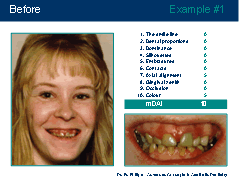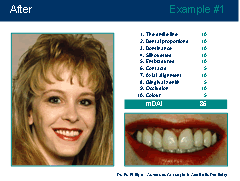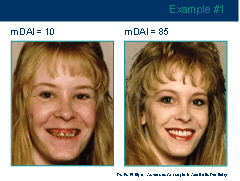
Smile Scores
One might argue that the beauty of a person’s smile is subjective and can’t be broken down into a universally accepted set of objective measurements, but in fact, several attempts have been made to do just that over the past years. The SASOC, DFA and Illustrated Scale all measure dental malocclusion. They don’t however look at a patient’s overall facial structure. Because of this they fall short as effective tools in our efforts to identify and measure all of the elements that make a person’s smile attractive.
Modified Dental Aesthetic Index (mDAI)
Another tool is the Dental Aesthetic Index (DAI), a system for analysing smiles that combines orthodontic measurements with socially defined aesthetic standards. The DAI grades a patient’s smile using a series of measurements and assessments.
Research over the past several years suggests that there is a more effective system for assessing our patient’s smiles. It is based on a set of 10 basic principles that cover at all aspects of a patient’s smile as it relates to their overall facial structure, and grades them using a simple system.
Using the DAI as a starting point, the criteria we use to grade a patient’s smile enhanced leading to development of the modified Dental Aesthetic Index or mDAI. With the mDAI we can assess each of the 10 smile design principles, and using a simple rating system, grade the patient’s overall smile.
This based on an article on Smile Classifications. A 10-point system for grading patients’ smiles is presented which would allow the profession to use a common language when discussing aesthetic treatments with our patients and colleagues. This system can be a valuable tool in the pre-diagnostic phase of treatment to provide an objective assessment of a patient’s smile, in the surgical phase as a guide to treatment, and in the post- surgical phase, when assessing the success of treatment.
Each aspect of a patient’s smile is assessed using specific criteria, and then graded on the following scale:
[table]
Rating,Points
Good,10
Acceptable,5
Unacceptable,0
[/table]
A smile that scored perfectly on each of the 10 principles would therefore rate a score of 100. Once the patient’s smile has been examined and graded on each of the 10 principles, their overall score is the categorised:
[table]
Overall score,Category
0 to 50,Unacceptable
50 to 70,Acceptable
70 to 100,Good
[/table]
Examples of mDAI



Conclusion
The field of dentistry is changing, as patients come to us for reasons other than rehabilitative. The subjective aspect of aesthetic dentistry will increasingly challenge our profession to establish objective communication skills when diagnosing and treating our patients.
By classifying Smile Patterns and applying a ten point systematic approach to Smile Analysis patients and practitioners will enjoy a common language which will effectively redirect the subjective components to objective criteria. The mDAI is an easy and effective way to quantify and qualify an other wise complicated and subjective area of assessment.

